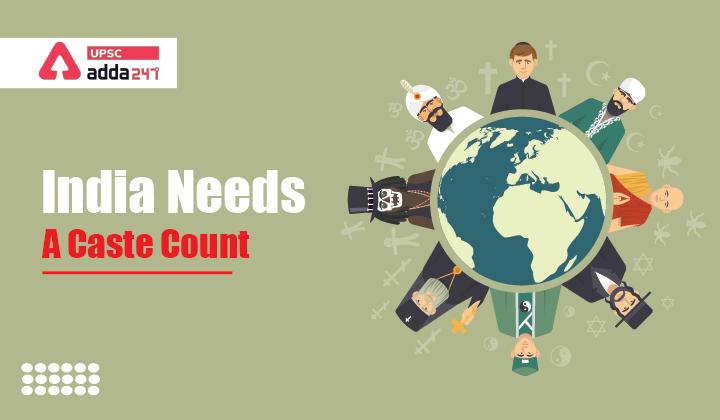Table of Contents
India Needs a Caste Count- Relevance for UPSC Exam
- GS Paper 1: Salient features of Indian Society- Population and Associated Issues.
- GS Paper 2: Governance, Administration and Challenges- Governance, Administration and Challenges
India Needs a Caste Count- Context
- Recently, the demand for a caste census is growing louder as its findings can be used to cross the 50% hurdle.
- If it can be empirically established that the OBCs are numerically higher, perhaps it could be argued that the 50% cap on the reservation is redundant.
With a Bang- IMD’s Rainfall Forecasting Model
Social Integration for Creating Casteless Society- Constitutional Provisions
- Constitutional Background: The Preamble of the Constitution: stated that there would be justice (social, economic and political) and equality of status and opportunity.
- Fundamental Rights: The Constitution provides for three Fundamental Rights in order to fulfill the egalitarian construct of the Constitution. These are-
- Article 17 (abolishing untouchability), Article 23 (prohibition of traffic in human beings and forced labour) and Article 24 (prohibition of child labour).
- The Constitution outlaws discrimination on the grounds of religion, race, caste, sex and place of birth and mandates equality of opportunity in matters of public employment albeit with caveats to promote the interests of the underprivileged.
- Provides for Social and Economic Empowerment of weaker sections: to bring about social integration that could pave the way for the creation of a classless ethos.
India Needs a Caste Count- Steps to Bring Reservation to Different Sections
- Constitutional Provisions: Part XVI of the constitution aims to provide a political voice to the disempowered.
- Part XVI: It delineates Special Provisions relating to certain classes, including reservation of seats for Scheduled Castes (SCs), Scheduled Tribes (STs) and Anglo-Indians in the Legislatures.
- Implementation of the Mandal Commission Report: The central government accepted the recommendations of the Mandal Commission report and provided 27% reservation in public employment to Other Backward Classes (OBCs).
- This was subsequently extended to educational institutions.
- This added to the existing 22.5% reservation quota for SCs and STs thereby increasing reservations in educational institutions to 49.5%.
- 103rd Constitutional Amendment Act: Provides for an economic reservation (10% quota) in jobs and admissions in educational institutes for Economically Weaker Sections (EWS) by amending Articles 15 and 16.
Bureaucracy’s Digital Challenge
India Needs a Caste Count- Associated Issues with the Reservation
- Indra Sawhney v. Union of India Judgement: Supreme Court upheld 27% reservation for OBCs but struck down the 10% quota based on economic criteria.
- It further fixed the ceiling of reservations at 50%.
- Reason for Rejection: It held that a “caste can be and quite often is a social class. If it is backward socially, it would be a backward class for the purposes of Article 16(4).”
- Introduced the concept of Creamy Layer: to ensure that those who really require reservation get it.
- Creating Silos: while reservations have ameliorated socio-economic backwardness, they have equally created silos whereby the benefits of reservation have been more far-reaching vertically than horizontally.
India Needs a Caste Count- Growing Demand for a Caste Census
- Socio-Economic and Caste Census in 2011: It was successfully conducted and implemented rigorously by the previous government.
- Parliamentary Standing Committee of Rural Development in 2016 observed that “the data has been examined and 98.87% data on individuals’ caste and religion is error-free”
India Needs a Caste Count- Way Forward
- Transforming India into an egalitarian and classless society: A new paradigm of affirmative action is required to fulfil the vision of the makers of independent India given that economic stimuli have not brought about societal integration.
- Conduct Fresh Socio-economic Caste Census: Since it has been judicially determined that caste is synonymous with class, a fresh socio-economic caste census is imperative for India.
- Formulate a new intervention strategy: This should be based on the data of the newly conducted socio-economic caste census.
- This should be done to emancipate caste groups that are still at the bottom of the ladder. Only when all castes are equal can society become egalitarian.




 TSPSC Group 1 Question Paper 2024, Downl...
TSPSC Group 1 Question Paper 2024, Downl...
 TSPSC Group 1 Answer key 2024 Out, Downl...
TSPSC Group 1 Answer key 2024 Out, Downl...
 UPSC Prelims 2024 Question Paper, Downlo...
UPSC Prelims 2024 Question Paper, Downlo...
